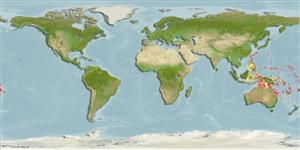Common names from other countries
分類 / Names
俗名 | 同種異名 | Catalog of Fishes(屬, 種) | ITIS | CoL | WoRMS | Cloffa
Environment: milieu / climate zone / depth range / distribution range
生態學
海洋 礁區魚類; 深度上下限 1 - 37 m (Ref. 86942). 熱帶; 28°N - 34°S, 115°E - 174°W (Ref. 5222)
Western Pacific: Ryukyu Islands south to Lord Howe Island and east to Howland Island and Samoa. Often misidentified as Epinephelus macrospilos or Epinephelus corallicola.
西太平洋: 琉球群島南至羅得豪島而且東至豪蘭群島與美屬薩摩亞。 時常被誤鑑成 大斑石斑魚〔Epinephelus macrospilos〕 或 黑駁石斑魚〔Epinephelus corallicola〕 。
Length at first maturity / 大小 / 重量 / 年齡
Maturity: Lm ?, range 24 - ? cm
Max length : 55.0 cm TL 雄魚/尚未辨別雌雄; (Ref. 48635)
背棘 (總數) : 11; 背的軟條 (總數) : 15 - 17; 臀棘: 3; 臀鰭軟條: 8. Distinguished by the following characteristics: head and body pale grey or brownish grey, covered with small brownish black spots with diffuse edges, separated from adjacent spots by spaces equal to or greater than width of the spots; body with black saddle blotch , smaller black saddle blotch on the caudal peduncle; dusky margins of the soft dorsal, caudal and anal fins, with white line along edge; median and pelvic fins with dark spots; dusky pectoral fins with few dark spots basally; body depth contained 2.9-3.3 times in SL; HL 2.2-2.5 times in SL; flat interorbital area, convex dorsal head profile; rounded preopercle, slightly enlarged serrae at angle; maxilla reaches past vertical at rear edge of eye; 2-4 rows of teeth on the midlateral part of lower jaw; pyloric caeca 13 (Ref. 89707).
頭部輪廓平滑中凸; 斑點眾多的而且間隔很密的超過在相同的大小的 E. corallicola 中.(參考文獻 37816)
Usually found over rocky areas or on coral reefs. Feeds on fishes and crustaceans (shrimps and crab) with occasional molluscs or worms (Ref. 89707). Nothing has been published on its biology. Appears to be very rare and therefore of little commercial importance. In Hong Kong live fish markets (Ref. 27253).
通常發現於岩石區或在珊瑚礁上之上。 尚未有任何文獻報告在它的生物學特性。 似乎非常稀有的因此小的商業重要性。 在香港活魚販售。 (參考文獻 27253)
Life cycle and mating behavior
Maturities | 繁殖 | Spawnings | Egg(s) | Fecundities | 仔魚
西太平洋: 琉球群島南至羅得豪島而且東至豪蘭群島與美屬薩摩亞。 時常被誤鑑成 大斑石斑魚〔Epinephelus macrospilos〕 或 黑駁石斑魚〔Epinephelus corallicola〕 。
Heemstra, P.C. and J.E. Randall, 1993. FAO Species Catalogue. Vol. 16. Groupers of the world (family Serranidae, subfamily Epinephelinae). An annotated and illustrated catalogue of the grouper, rockcod, hind, coral grouper and lyretail species known to date. Rome: FAO. FAO Fish. Synop. 125(16):382 p. (Ref. 5222)
IUCN 瀕危狀態 (Ref. 130435)
無危 (LC) ; Date assessed: 22 November 2016
CITES (Ref. 128078)
Not Evaluated
人類使用
漁業: 自給性漁業; 水族館: 公眾的水族館
工具
特別的報告
下載 XML
網路資源
Estimates based on models
Preferred temperature (Ref.
115969): 24.7 - 28.9, mean 27.5 (based on 268 cells).
Phylogenetic diversity index (Ref.
82804): PD
50 = 0.5000 [Uniqueness, from 0.5 = low to 2.0 = high].
Bayesian length-weight: a=0.01175 (0.00790 - 0.01748), b=3.04 (2.93 - 3.15), in cm Total Length, based on LWR estimates for this species & Genus-body shape (Ref.
93245).
營養階層 (Ref.
69278): 4.0 ±0.64 se; based on food items.
回復力 (Ref.
120179): 中等的, 族群倍增時間最少 1.4 - 4.4年 (Preliminary K or Fecundity.).
Fishing Vulnerability (Ref.
59153): Moderate vulnerability (42 of 100).
